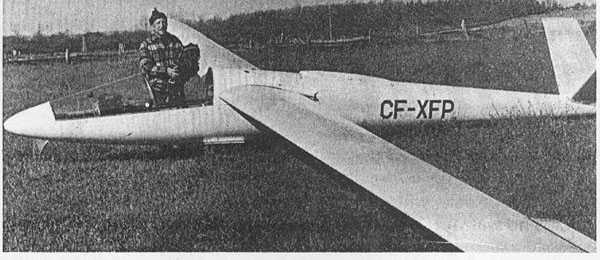
The New Look of a Canadian Built HP-14
Free Flight Nov-Dec '75

The persistent spirit of a contest pilot has been the primary ingredient in the development of the first Canadian build motorglider.
Willi Deleurant of Toronto Soaring Club has been flying gliders for 45 years. He holds Canada's Diamond Badge #10 and won the National Contest in 1960 and 1965 plus coming second in '61, '68 and '69.
For the past three years Willi's long experience in gliding plus his business background in auto mechanics has been applied to developing an efficient motorglider adaptation for his HP-14.
The first effort in 1973 was a fuselage mounted engine, folding pylon and geared drive that looked great but wouldn't do the job. The next year was a change to belt drive but still with the inefficient under powered engine. This season, a new engine with belt drive and a new "Hoffman" propeller are getting Willi off the ground and climbing at 300 ftm.
|
|
|
Finding the materials to fit into the limited space available (16 1/2" x 22") and producing the performance needed has been half the battle. A friend, George McNair, owner of the Delta Machine Shop in Toronto has been a big help and the dogged persistence Willi used to show in soaring contests has produced a winner again.
Why make a high performance sailplane like the HP-14 into a motorglider? Not to fly underpower says Willi; all he wants is the chance to launch himself for soaring flight and avoid the landing out problems. He only uses a one gallon tank which gives him about a half hour of power but this can be enlarged if needed. Willi's dislike of landing out was increased at the World Contest in Marfa in 1970 when he had a 28 mile walk out of the boondocks. With his hydraulic unfolding mechanism and electric start, he can get under power in seconds when he gets low and avoid retrieves or a long walk for help.
The powerplant is a modified OMC snowmobile 23 H.P., two stroke engine; turning up to 6000 rpm. An electric starter is used with a 12 volt 40 amp snowmobile battery housed in the nose for counterbalancing the engine weight. The belt drive and a ratio of 2:1 turns the prop at 3000 rpm.
The movement of the powerplant after opening the doors is accomplished by hydraulic pressure stored in an accumulator, operating a ram type cylinder. To erect or retract the powerplant takes only a couple of seconds and no effort by the pilot; and because of the minimal change in centre of gravity when the engine moves, no change in airspeed is necessary when changing from the gliding to the power mode. The powereplant may be completely removed from the aircraft by unscrewing six bolts and connections plus removing the battery, thus restoring the glider to a pure sailplane. While the performance of the version shown in the photographs is quite acceptable; Willi is not satisfied. He is already planning his next adaptation which will be to house the engine within the fuselage retaining the belt drive inside a pylon. This will reduce drag substantially without affecting the present reliability.
Desire, technical skill and continuous effort have brought Willi to his present performance and he says, "Wait til next year ...". It will be even better!"